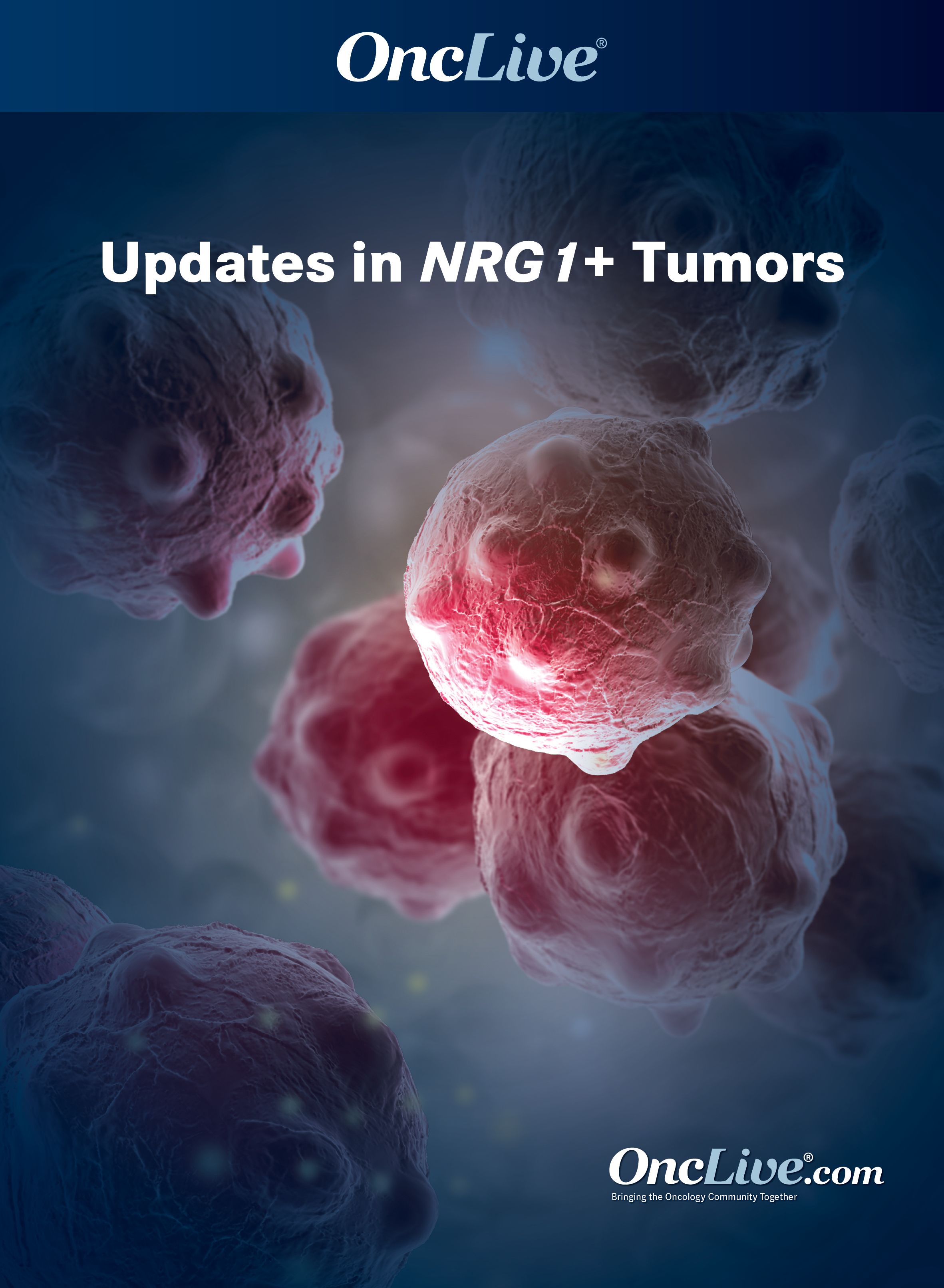Publication
Article
Supplements and Featured Publications
Afatinib Efficacy and Safety to Be Investigated in Metastatic Solid Tumors With NRG1 Fusions
Author(s):
Afatinib may prove effective and tolerable in patients with advanced or metastatic solid tumors with NRG1 gene fusions, according to the rationale for a prospective real-world outcomes study that was presented as a trial in progress at the 2022 ASCO Annual Meeting.
Stephen V. Liu, MD

Afatinib (Gilotrif) may prove effective and tolerable in patients with advanced or metastatic solid tumors with NRG1 gene fusions, according to the rationale for a prospective real-world outcomes study (NCT05107193) that was presented as a trial in progress at the 2022 ASCO Annual Meeting.1
Around 0.2% of all solid tumors contain oncogenic NRG1 gene fusions,2 including around 31% of cases of invasive mucinous adenocarcinoma of the lung.3 NRG1 fusions occur in a range of solid tumor types, such as non–small cell lung cancer; head and neck cancer; KRAS wild-type pancreatic cancer; renal cell carcinoma; and ovarian, breast, prostate, and uterine tumors.
NRG1 proteins are soluble ligands with an EGF-like domain that binds to ErbB3 (HER3) and stimulates downstream signaling pathways. These fusion proteins can provide an extracellular anchor for NRG1, keeping the ligand near its receptor to increase binding to HER3, which leads to oncogenic activation of the signaling pathways and inappropriate ErbB3 heterodimerization, usually with HER2.
“Targeted treatment with inhibitors of the HER pathway represent a possible therapeutic strategy,” Stephen V. Liu, MD, an associate professor of medicine, director of Thoracic Oncology, and director of Developmental Therapeutics at the Lombardi Comprehensive Cancer Center at Georgetown University, said in a presentation of the data. “Afatinib, an irreversible pan-ERbB TKI, has already demonstrated durable responses in individual patients with NRG1 fusion–positive tumors, representing a potential treatment option in this setting.”
This novel, decentralized, US-based study aims to investigate afatinib as a potential targeted therapy for this patient population, for which no such approved treatment yet exists.
The study will include a maximum of 40 patients who are at least 18 years of age. Enrollment criteria stipulate that patients must have histologically or cytologically confirmed advanced, unresectable, or metastatic non-hematologic tumors with an NRG1 fusion, with any coding gene as the fusion partner. The NRG1 break point must occur before exon 6 on chromosome 8 to ensure conservation of the EGF domain. Eligible patients must also have at least 1 measurable or evaluable lesion per RECIST v1.1 criteria.
Patients will be excluded if they received prior systemic anticancer therapy or an investigational drug within 14 days or 5 half-lives of the start of afatinib treatment. Patients will also be ineligible if they have an actionable non–NRG1 fusion driver mutation with an available FDA-approved targeted therapy. Other exclusion criteria include prior treatment with an ErbB-targeted therapy and any other criteria that may render the patient ineligible according to the treating physician.
In this study, afatinib will be administered on a single-patient protocol as an investigational new drug to patients with tumors harboring NRG1 fusions. Participating molecular testing providers will identify eligible fusions with routine diagnostic assays. Once a testing laboratory prospectively confirms a patient’s NRG1 fusion–positive solid tumor, they will notify the patient’s primary oncologist or treating physician of the study as a potential treatment option. They will also learn about the scientific significance of the study and how the patient matches the enrollment criteria.
From there, the physician or oncologist will need to contact the study sponsor, Boehringer Ingelheim, to confirm patient eligibility. After the sponsor obtains central Institutional Review Board (IRB) approval and the physician or oncologist notifies their local IRB, the patient will be consented, screened, and enrolled in the study, so they can begin afatinib treatment at their existing point of care center. The recommended dose of oral afatinib is 40 mg once daily.
During the study, the physician or oncologist will enter limited patient data into a mean electronic case report form (eCRF) that will include basic patient characteristics, as well as necessary information about treatment, response, and safety.
Computed tomography (CT) scans will be performed before treatment begins, as well as every 6 weeks until disease progression or the start of further treatment. After 48 weeks, CT scans will be performed every 12 weeks. These scans will be uploaded to a central imaging portal, then transferred to a central imaging assessment if patients achieve complete response (CR), partial response (PR), or stable disease.
Treatment will end when patients reach progressive disease (PD) or when the treatment is no longer tolerated.
The primary end point of this study is the confirmed objective response rate (ORR) by RECIST v1.1 criteria, defined as the best overall response of either CR or PR, analyzed as the proportion of patients who achieve objective response by independent central review. A key secondary end point is the duration of objective response, defined as the time from the first documented objective response to disease progression or death. Other secondary end points include time to objective response, disease control, and safety coded using the Medical Dictionary for Drug Regulatory Activities.
“The decentralized nature of this study means that any oncologist who has a patient with an NRG1 fusion can participate,” Liu concluded. This study is open for enrollment.
References
- Liu SV, Minasi LAE, Herpers M, et al. Efficacy of afatinib in patients with advanced/metastatic solid tumors harboring NRG1 gene fusions: a novel, prospective real-world outcomes study based on single-patient protocol data. J Clin Oncol. 2022;40(suppl 16)TPS3180. doi:10.1200/JCO.2022.40.16_suppl.TPS3180
- Laskin J, Liu SV, Tolba K, et al. NRG1 fusion-driven tumors: biology, detection, and the therapeutic role of afatinib and other ErbB-targeting agents. Ann Oncol. 2020;31(12):1693-1703. doi:10.1016/j.annonc.2020.08.2335
- Cadranel J, Liu SV, Duruisseaux M, et al. Therapeutic potential of afatinib in NRG1 fusion-driven solid tumors: a case series. Oncologist. 2021;26(1):7-16. doi:10.1634/theoncologist.2020-0379
































%20(2)%201-Recovered-Recovered-Recovered-Recovered-Recovered-Recovered-Recovered-Recovered-Recovered-Recovered-Recovered-Recovered-Recovered-Recovered-Recovered-Recovered-Recovered.jpg?fit=crop&auto=format)
%20(2)%201-Recovered-Recovered-Recovered-Recovered-Recovered-Recovered-Recovered-Recovered-Recovered-Recovered-Recovered-Recovered-Recovered-Recovered-Recovered-Recovered-Recovered.jpg?fit=crop&auto=format)
